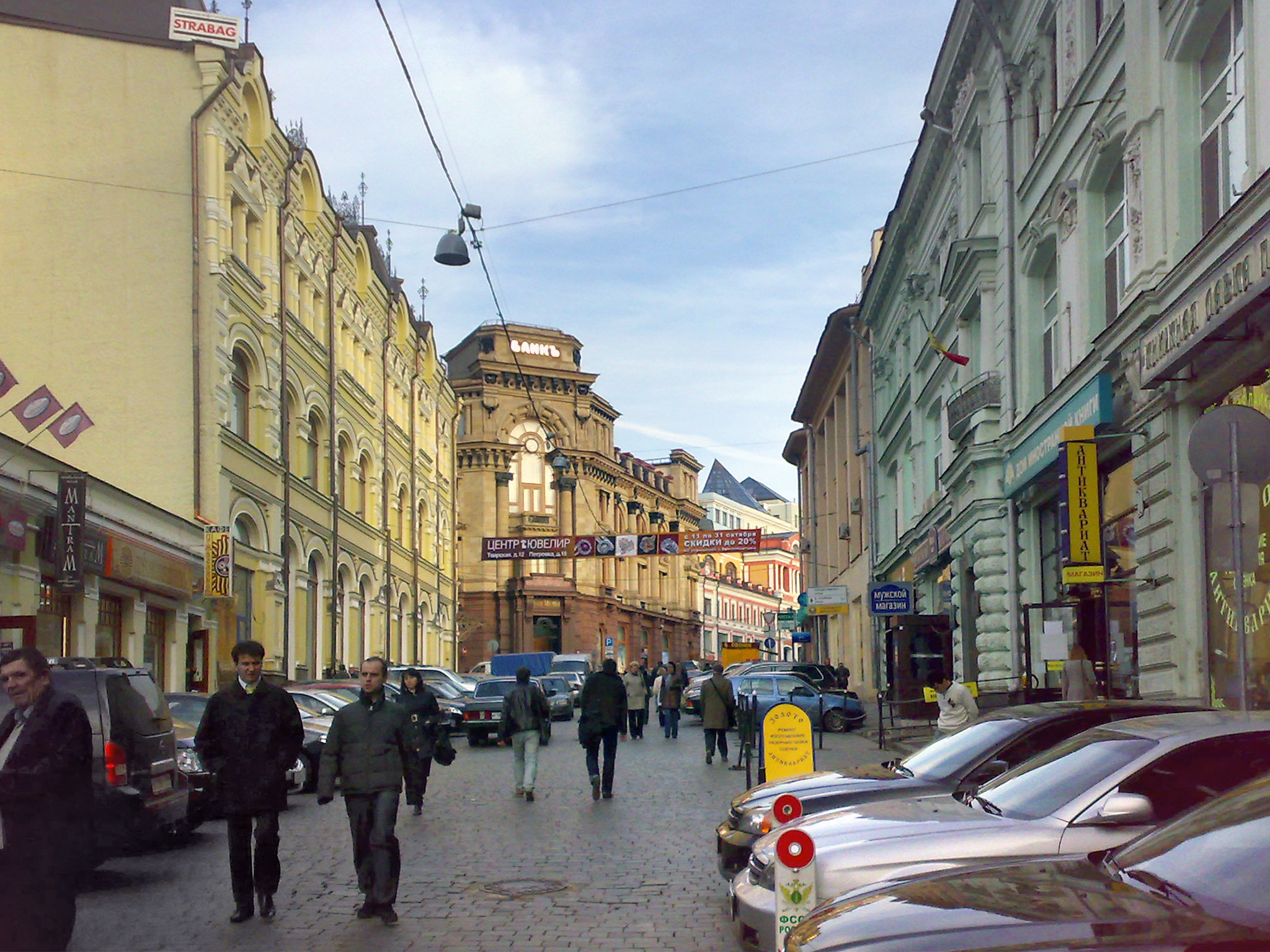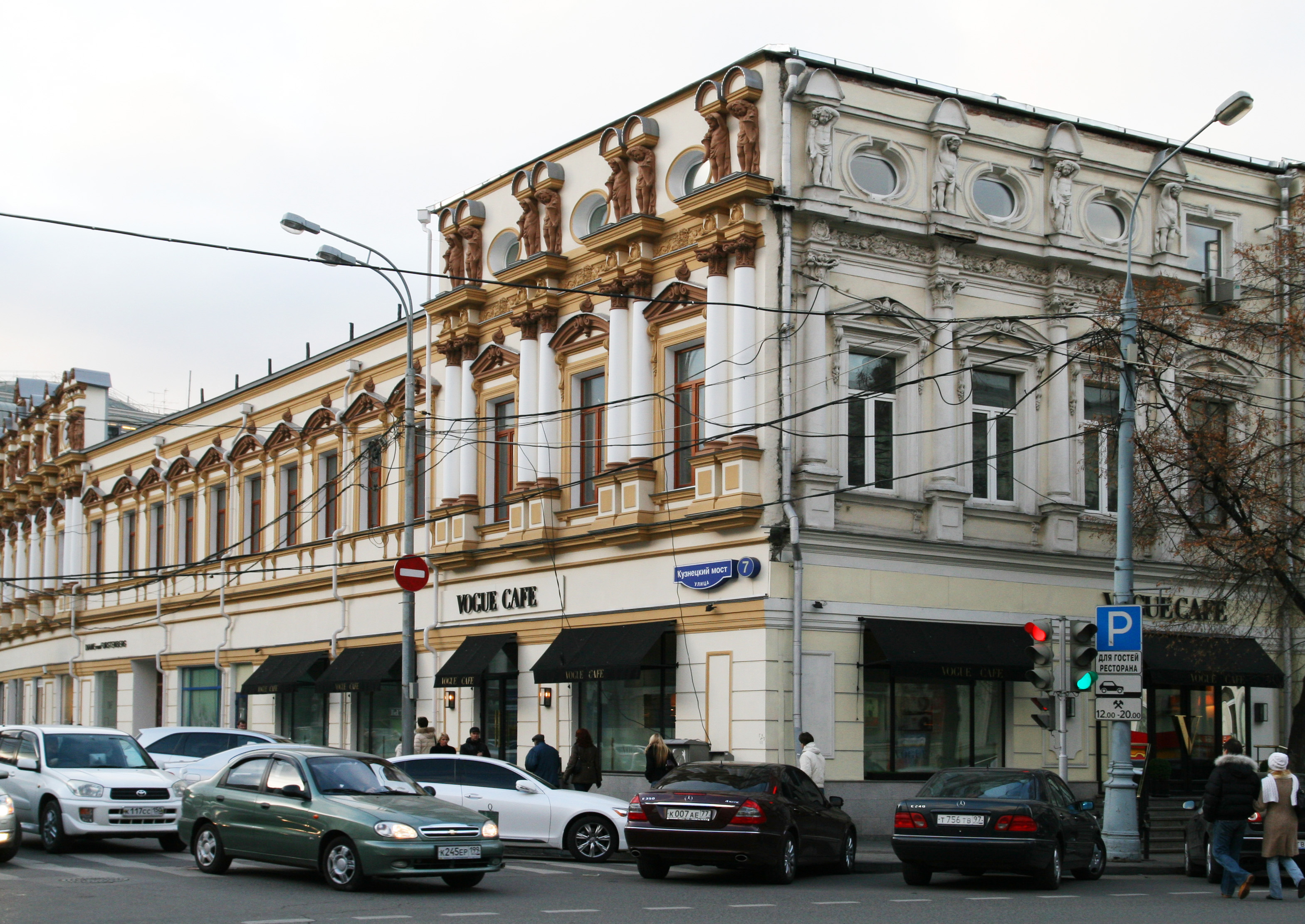Kuznetsky Bridge Street on:
[Wikipedia]
[Google]
[Amazon]

 Kuznetsky Most ( rus, Кузне́цкий Мост, p=kʊˈzʲnʲet͡skʲɪj ˈmost) is a street in central Moscow, that runs from Bolshaya Dmitrovka Street to Lubyanka Street. The name, literally ''Blacksmith's Bridge'', refers to the 18th-century bridge over the (now underground) Neglinnaya River, and a nearby foundry and the settlement of its workers. Since the middle of the 18th century, Kuznetsky Most has been a fashionable shopping street.
The street is administered by
Kuznetsky Most ( rus, Кузне́цкий Мост, p=kʊˈzʲnʲet͡skʲɪj ˈmost) is a street in central Moscow, that runs from Bolshaya Dmitrovka Street to Lubyanka Street. The name, literally ''Blacksmith's Bridge'', refers to the 18th-century bridge over the (now underground) Neglinnaya River, and a nearby foundry and the settlement of its workers. Since the middle of the 18th century, Kuznetsky Most has been a fashionable shopping street.
The street is administered by
 Until the end of 15th century, Moscow was growing eastward, into Kitai-gorod. Prince Ivan III of Russia established his arsenal (Пушечный двор, Cannon Court) in the west, beyond the Neglinnaya river. Later, he also set up a settlement of former
Until the end of 15th century, Moscow was growing eastward, into Kitai-gorod. Prince Ivan III of Russia established his arsenal (Пушечный двор, Cannon Court) in the west, beyond the Neglinnaya river. Later, he also set up a settlement of former
 The Fire of Moscow (1812) spared Kuznetsky Most, where
The Fire of Moscow (1812) spared Kuznetsky Most, where
File:Vasnetsov Pushechno-Liteyny dvor.jpg, Kuznetsky Most and Cannon yard in the 16th century. Reconstruction by A. Vasnetsov
File:Kuz most 18v.jpg, Kuznetsky Most in the 18th century.
File:Kuz most-1834.jpg, Kuznetsky Most in 1834
File:Kuz most-1834-2.jpg, Kuznetsky Most in the middle of 19th century
File:Kuzneckij most-11.jpg, Kuznetsky Most, a view to side of the street Lubyanka, the end of the 19th century
File:Kuz most 25.jpg, Kuznetsky Most. A view from the street Neglinnaya to side of the street Petrovka the end of the 19th century
File:Kuz most-7.jpg, Kuznetsky Most. A view from the street Petrovka to side of the street Rozhdestvenka, 1912
File:Kuz most 39 perekrestok-Rojdestvenki.jpg, Kuznetsky Most. A view from the street Rozhdestvenka to side of the street Lubyanka, the beginning of the 1930s
File:Кузнецкий пост после пересечения с Петровкой (Moscow clad in snow).jpg, Kuznetsky Most in 1908

 Kuznetsky Most ( rus, Кузне́цкий Мост, p=kʊˈzʲnʲet͡skʲɪj ˈmost) is a street in central Moscow, that runs from Bolshaya Dmitrovka Street to Lubyanka Street. The name, literally ''Blacksmith's Bridge'', refers to the 18th-century bridge over the (now underground) Neglinnaya River, and a nearby foundry and the settlement of its workers. Since the middle of the 18th century, Kuznetsky Most has been a fashionable shopping street.
The street is administered by
Kuznetsky Most ( rus, Кузне́цкий Мост, p=kʊˈzʲnʲet͡skʲɪj ˈmost) is a street in central Moscow, that runs from Bolshaya Dmitrovka Street to Lubyanka Street. The name, literally ''Blacksmith's Bridge'', refers to the 18th-century bridge over the (now underground) Neglinnaya River, and a nearby foundry and the settlement of its workers. Since the middle of the 18th century, Kuznetsky Most has been a fashionable shopping street.
The street is administered by Tverskoy District
Tverskoy District ( rus, Тверско́й райо́н, p=tvʲɪrˈskoj, a=Ru-Тверской.ogg) is a district of Central Administrative Okrug of the federal city of Moscow, Russia. Population:
The district extends from Kitai-gorod north ...
(west) and Meshchansky District (east).
History
Early history
Pskov
Pskov ( rus, Псков, a=pskov-ru.ogg, p=pskof; see also names in other languages) is a city in northwestern Russia and the administrative center of Pskov Oblast, located about east of the Estonian border, on the Velikaya River. Population ...
residents, abducted from their hometown after the wars of the 1480s. Population grew slowly until the 1737 fire which razed the area.
The Bridge
Soon after the fire, the territory was built out with upper-class buildings and shops. Large territories north from the street were consolidated by the Vorontsov family estate. In 1754-57, architect Semyon Yakovlev built a stone bridge over Neglinnaya River to a design byDmitry Ukhtomsky
Prince Dmitry Vasilyevich Ukhtomsky (russian: Дмитрий Васильевич Ухтомский; 1719–1774) was the chief architect of Moscow, Russian Empire during the reign of Empress Elizabeth of Russia.
Biography
Ukhtomsky was b ...
. The bridge over Neglinnaya lowlands extended 120 meters long and 12 meters wide; the shops between Kuznetsky Bridge and Vorontsov lands were literally standing on the edge of this bridge. The street was known as the home of notorious Darya Saltykova (1730-1801), condemned to life in prison for torturing her slaves.
19th century
 The Fire of Moscow (1812) spared Kuznetsky Most, where
The Fire of Moscow (1812) spared Kuznetsky Most, where Napoleon
Napoleon Bonaparte ; it, Napoleone Bonaparte, ; co, Napulione Buonaparte. (born Napoleone Buonaparte; 15 August 1769 – 5 May 1821), later known by his regnal name Napoleon I, was a French military commander and political leader who ...
's Guards were stationed in defense of the French colony in Moscow. In 1817-1819, the city locked the Neglinnaya River in a tunnel and demolished the redundant bridge - excluding its northern wall that supported surviving buildings. Soon, the French colony returned and Kuznetsky Bridge became the street of bookstores, fashion and upper-class shopping, mostly managed by the French. ''Kuznetsky Most'' became the symbol of French influence on Russians, immortalized in Woe from Wit by Alexandr Griboyedov
Alexander Sergeyevich Griboyedov (russian: Александр Сергеевич Грибоедов, ''Aleksandr Sergeevich Griboedov'' or ''Sergeevich Griboyedov''; 15 January 179511 February 1829), formerly romanized as Alexander Sergueevich Gri ...
.
After Emancipation reform of 1861
The emancipation reform of 1861 in Russia, also known as the Edict of Emancipation of Russia, (russian: Крестьянская реформа 1861 года, translit=Krestyanskaya reforma 1861 goda – "peasants' reform of 1861") was the first ...
, Kuznetsky Most became the financial center of Moscow, with historical Juncker Bank Building and Dzhamgarov Bank built in the 1890s. Art Nouveau
Art Nouveau (; ) is an international style of art, architecture, and applied art, especially the decorative arts. The style is known by different names in different languages: in German, in Italian, in Catalan, and also known as the Modern ...
landmark by Ivan Mashkov, the ''Sokol'' building (3, Kuznetsky Most) was built in 1903-1904. However, at that time its address was Kuznetsky Lane: the part of Kuznetsky Most west of Petrovka Street was then known as Kuznetsky Lane; two streets were merged only in 1922.
Modern history
In the 1920s, the Bolshevik administration demolished the church on the corner of Kuznetsky Most and Lubyanka Street, creating Vorovsky Square. Nearby blocks were gradually converted to KGB offices after World War II; the blocks facing Lubyanka Square were torn down to make way for theMinistry of the Maritime Fleet
The Ministry of the Maritime Fleet (Minmorflot; russian: Министерство морского флота СССР) was a government ministry in the Soviet Union.
The Merchant Maritime Fleet of the USSR is abbreviated Morflot (). All Soviet ...
and Alexey Dushkin's Detsky Mir department store. The latter was restored in 2014 and now hosts the world's largest mechanical clock, " Raketa Monumental". Since the 1980s, the street has regained its status as an upper-class shopping lane, notably with the rebuilding of Roman Klein's historical TsUM store. Among cultural institutions located on the street are the Moscow Operetta Theater, Kuznetsky Most Exhibition Hall, as well as two major state libraries.
Rapid transit
Kuznetsky Most, Lubyanka and Okhotny Ryad stations of the Moscow Metro are located nearby.Gallery
References
* Russian: П.В.Сытин, "Из истории московских улиц", М, 1948 (Sytin) {{coord, 55, 45, 42, N, 37, 37, 12, E, region:RU_type:landmark_source:kolossus-ruwiki, display=title Shopping districts and streets in Russia Streets in Moscow Tourist attractions in Moscow